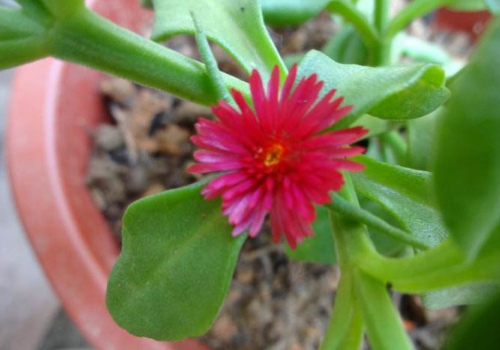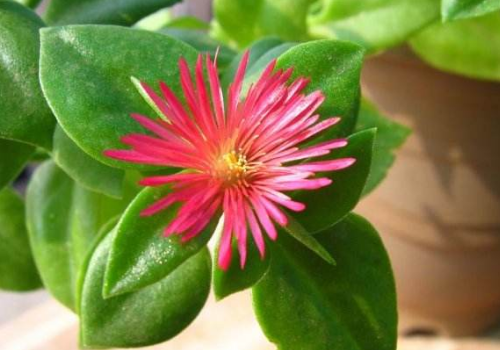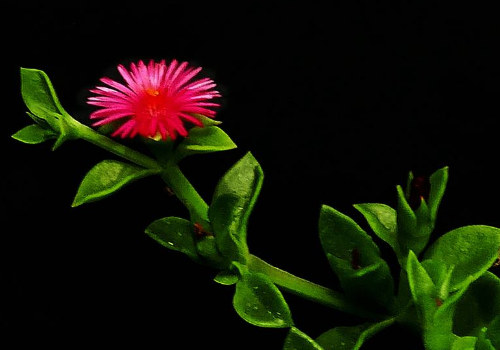What is the difference between peony hanging orchid root rot and Tianqi?
Tianqi is a very valuable medicinal material in China, which is somewhat similar to Peony Cymbidium in appearance. Peony hanging orchid rotten root how to do? What is the difference between Tian Qi and Tianqi?
Peony hanging orchid rotten root how to do:
1. Pruning during winter dormancy
In winter, the peony orchid enters the dormant period, and the leaves no longer grow. At this time, we must pay attention to timely pruning off some unhealthy pieces of paper, such as disease and insect branches, overlapping branches, growing branches, weak branches, old branches, inward growing branches and growing branches, so as to prevent diseases and pests from infringing on other healthy branches. at the same time, the nutrient solution does not need to be wasted on some redundant branches, which will help peony orchid store energy and prolong its life during dormancy, and grow better in the coming year.
2. Pruning of peony orchid in normal growing period.
For the peony orchid in the prosperous period, due to its rapid growth during this period, it needs to be pruned regularly according to the plant growth to ensure the beauty of the plant type. The correction of plant type can be built at will according to personal preference, and there is no too standard index. Some flower lovers can build their own scaffolding and let them grow naturally if they are unwilling to cut it. In addition, here is a little secret. If you want to make your peony orchid branches more luxuriant and luxuriant, you can take the way of core-pinching, that is, cutting off the top of the longer branches in the middle to make them grow new buds and then turn them into branches. Continuous circulation of this action, can make the plant send out more buds, so that the plant type is more full, very beautiful.

What is the difference between Peony Cymbidium and Tianqi:
1. Different families and genera
The family and genus of peony orchid: peony orchid is a kind of begonia plant, which is native to southern Africa. Cultivated in our country is only for ornamental use.
The families and genera of Tianqi: Tianqi is a kind of Panax ginseng plant of Araliaceae, which is unique to China and has great medicinal value.
2. Different appearance characteristics.
Peony hanging orchid: its stem is relatively thin, very slim, fleshy and very thick, bright and green color. There are edges and corners on the branches, and when they elongate, they become semi-creeping.
Tian Qi: its rhizome as well as the branches and leaves of the plant grow upright, and the leaves are serrated, so they are not smooth and smooth.
Now you know the difference between Peony Cymbidium and Tian Qi.
What is the difference between Tianqi and peony orchids? what about the rotten roots of peony hanging orchids?
The leaves of peony orchid are lush and green, and the rose flowers set off each other. It not only has high ornamental value, but also has the characteristics of purifying air. It is often used to make hanging orchids and put them on windowsills, desktops and other places. Tianqi is a very valuable medicinal material in China, which is somewhat similar to Peony Cymbidium in appearance. Let's take a look at their differences.
What is the difference between Tianqi and Peony Cymbidium
1. Different families and genera
The family and genus of peony orchid: peony orchid is a kind of begonia plant, which is native to southern Africa. Cultivated in our country is only for ornamental use.
The families and genera of Tianqi: Tianqi is a kind of Panax ginseng plant of Araliaceae, which is unique to China and has great medicinal value.
2. Different appearance characteristics.
Peony hanging orchid: its stem is relatively thin, very slim, fleshy and very thick, bright and green color. There are edges and corners on the branches, and when they elongate, they become semi-creeping.
Its leaves are oblong and opposite; it grows obliquely and has many branches; the flower of the peony orchid, a single terminal at the top of the branch or axillary, is inverted conical; the petals are mostly red-purple, growing in the shape of a spoon, and the center is yellowish, shaped like a chrysanthemum, flowering between spring and autumn for a long time.
Tian Qi: its rhizome as well as the branches and leaves of the plant grow upright, and the leaves are serrated, so they are not smooth and smooth.
The leaves of Tianqi are very thin, which are wider and larger than peony orchids, and are covered with fluff. The flowers grow in globular shape, and the petals are thick and small, clustered together, so lush like a ball, the flower branch is very long, on which a single flower is born.
What about the rotten roots of peony hanging orchid?
1. Pruning during winter dormancy
In winter, the peony orchid enters the dormant period, and the leaves no longer grow. At this time, we must pay attention to timely pruning off some unhealthy pieces of paper, such as disease and insect branches, overlapping branches, growing branches, weak branches, old branches, inward growing branches and growing branches, so as to prevent diseases and pests from infringing on other healthy branches. at the same time, the nutrient solution does not need to be wasted on some redundant branches, which will help peony orchid store energy and prolong its life during dormancy, and grow better in the coming year.
2. Pruning of peony orchid in normal growing period.
For the peony orchid in the prosperous period, due to its rapid growth during this period, it needs to be pruned regularly according to the plant growth to ensure the beauty of the plant type. The correction of plant type can be built at will according to personal preference, and there is no too standard index. Some flower lovers can build their own scaffolding and let them grow naturally if they are unwilling to cut it. In addition, here is a little secret. If you want to make your peony orchid branches more luxuriant and luxuriant, you can take the way of core-pinching, that is, cutting off the top of the longer branches in the middle to make them grow new buds and then turn them into branches. Continuous circulation of this action, can make the plant send out more buds, so that the plant type is more full, very beautiful.
Matters needing attention in Peony Cymbidium Culture
1. Growth environment:
Peony Cymbidium likes the environment of warm and dry, permeable air and good ventilation, so it is suitable to cultivate it with sandy soil with good drainage.
2. Growth temperature:
It is better to keep the growth environment temperature at about 15 degrees. The low temperature in winter will enter the dormancy period, so it is necessary to do a good job of heat preservation in advance.
3. Fertilizer and water demand:
Generally, spring and summer is the peak growth period of peony orchid, during which there is a great demand for fertilizer and water; after late autumn, peony orchid grows slowly and there is no great demand for fertilizer and water.
How to plant the seeds of peony orchid
1. Collection and treatment of seeds
First of all, when the seed is ripe, it should be collected in time, and don't wait for it to be too mature before picking, which is not good. After picking, store it in a cool, dry place and wait for planting in the early spring of the following year.
2. Treatment before sowing
Soak in water of about 50 degrees Celsius, stir continuously for about 20 minutes, then fish it out and soak it in clean water for another four or five hours. Next, wrap them in a wet cloth and place them in an environment of 28 to 30 degrees. When you see it white, you can sow the seeds. Although these treatments may seem troublesome, they are very effective in improving their chances of germination.
3. Selection of containers and substrates
For containers, the performance of drainage is mainly considered. For the matrix, we should choose sandy soil with rich nutrients and strong drainage capacity.
4. Time selection
Under normal circumstances, we will choose to sow in spring, when it is warmer, the survival rate of seeds will be higher accordingly.
5. Sowing and management in the later stage
First of all, put most of the matrix into the container, not too full. After loading, sow the seeds and cover them with a thin layer of soil. Then, we have to keep all kinds of factors appropriate and wait for the seeds to germinate.
Peony hanging orchid and Tianqi still have many differences, as long as we observe carefully or very easy to distinguish. The peony orchid needs to control the water, fertilizer and temperature in the process of culture. only in this way can the peony orchid thrive.
What is the reason for the rotten roots of Cymbidium? what about the rotten roots of Cymbidium / watering and fertilization is the key point when planting Cymbidium, we will often encounter some headaches, such as yellowing leaves, rotting roots and so on. What is the reason if the roots of Cymbidium are rotten? What about the rotten roots of hanging orchids? The editor will answer in detail for all netizens. What is the reason for the rotten roots of hanging orchids?
Rotten root is obviously not a normal phenomenon, so what is the reason for hanging orchid rotten root? After statistics, there are three main reasons, namely: too much watering, excessive fertilization, poor soil permeability, so it is necessary to investigate the specific reasons from these three aspects.
1. Overwatering
Hanging orchid growth needs water, but too much watering will make the root soak in water for a long time, over time will cause root rot, you can associate whether there is often stagnant water in the basin in the process of planting, if there is, it means that the root rot is this reason.
2. Excessive fertilization
Fertilization is essential when raising Cymbidium, but when we apply too much fertilizer, it will not only cause the leaves to turn yellow, but also lead to root rot. We have introduced how to deal with the yellowing of the leaves and the rotten roots of Cymbidium. It is critical to reduce the amount and concentration of fertilizer.
3. Soil permeability is poor.
Poor air permeability may cause two problems, namely, the irrigated water can not be absorbed by the lower roots, and when the irrigated water is too much, it cannot be discharged through the holes in the basin bottom. if the upper root is found to rot, while the lower root is normal, then it is likely to be the reason for the poor permeability.
What about the rotten roots of hanging orchids?
1. Remove the orchid from the basin soil
When rotten roots appear, the orchid should be dug out of the basin soil, the rotten roots should be cut off, and then the roots should be disinfected.
2. Disinfect the root
Disinfect the roots with potassium permanganate solution or carbendazim solution, which can be purchased in a professional place. if there is no corresponding medicine, wash the roots with clean water and then put them in a ventilated place to dry. Do not put them in direct sunlight.
3. Re-cultivation
After disinfecting the roots, you need to transplant to a new potted soil. Specific steps and methods can refer to the breeding methods and matters needing attention of hanging orchids.
4. Late maintenance
After re-cultivation, attention must be paid to changing the maintenance methods, and the phenomenon of rotting roots before should be avoided, so attention should be paid not to excessive watering and fertilization concentration should not be too high. The soil should be mainly sandy soil with good air permeability.
- Prev

How do peony orchids grow yellowing leaves in winter?
The peony orchid has to slowly reduce the amount of water from autumn, and it is basically unwatered or rarely watered in winter. How to raise peony orchid in winter? What is the yellowing of leaves: how to raise peony orchids in winter: preparation for overwintering, before the arrival of winter
- Next

How to apply fertilizer to peony spider plants without flowering?
Peony spider plant is a kind of flowering fleshy, but there are many people who raise peony spider plant and find that their flesh shows no signs of flowering. How to fertilize peony spider orchid? How to do without flowering: peony spider how to fertilize: fertilizer and soil, peony spider is a foreign species
Related
- Fuxing push coffee new agricultural production and marketing class: lack of small-scale processing plants
- Jujube rice field leisure farm deep ploughing Yilan for five years to create a space for organic food and play
- Nongyu Farm-A trial of organic papaya for brave women with advanced technology
- Four points for attention in the prevention and control of diseases and insect pests of edible fungi
- How to add nutrient solution to Edible Fungi
- Is there any good way to control edible fungus mites?
- Open Inoculation Technology of Edible Fungi
- Is there any clever way to use fertilizer for edible fungus in winter?
- What agents are used to kill the pathogens of edible fungi in the mushroom shed?
- Rapid drying of Edible Fungi

